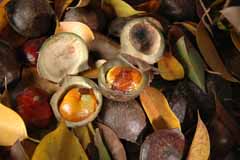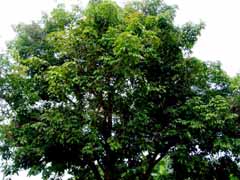 |
|
https://commons.wikimedia.org/wiki/User:Hariadhi |
 |
| Ahmad Fuad Morad flickr |
Translate this page:
Summary
Jengkol or Archidendron jiringa is a tropical shrub or tree of up to 21 m tall and 60 cm of trunk diameter. It has a spreading crown, compound bipinnate leaves, cream to white clustered flowers, and a dark brown pod fruit. Seeds are believed to relieve diabetes symptoms. Burnt old leaves can be used against itching while burnt young leaves can be used as wound powder for cuts. Seeds are edible - either raw or cooked. However, seeds can contain djenkolic acid which is an amino acid that is toxic and causes djenkolism. Young leaves are cooked and the very young shoots and flowers are eaten as vegetables. Fruits are also edible. Further, Jengkol is a great source of purple dye for silk, black dye, and reddish dye. The pods are used as a shampoo. The bark, leaves, and seeds have insecticidal properties. The wood is soft and used for cabinet work and for fuel.
Physical Characteristics

 Archidendron jiringa is an evergreen Tree growing to 20 m (65ft) by 20 m (65ft) at a medium rate.
Archidendron jiringa is an evergreen Tree growing to 20 m (65ft) by 20 m (65ft) at a medium rate.
See above for USDA hardiness. It is hardy to UK zone 10. The flowers are pollinated by Moths, insects.
It can fix Nitrogen.
Suitable for: light (sandy), medium (loamy) and heavy (clay) soils, prefers well-drained soil and can grow in heavy clay soil. Suitable pH: mildly acid, neutral and basic (mildly alkaline) soils and can grow in very acid and very alkaline soils.
It can grow in semi-shade (light woodland) or no shade. It prefers moist soil.
UK Hardiness Map
US Hardiness Map
Synonyms
Albizia jiringa (Jack) Kurz Feuilleea jiringa (Jack) O.Kuntze Inga jiringa Jack ex DC. Inga kaeringa
Plant Habitats
Edible Uses
Edible Parts: Flowers Fruit Leaves Seed Seedpod Shoots
Edible Uses:
Edible portion: Pods - flavouring, Shoots, Seeds, Spice, Leaves. Seed - raw or cooked[ 301 ]. The seed has a powerful odour that many people find objectionable[ 63 ]. Young seeds are often eaten raw[ 303 ]. Generally the young seeds are believed to have a better flavour than older ones, though some people prefer to eat germinating mature seeds[ 306 ]. The seedpod is 20 - 25cm long and 3 - 4cm wide, twisted in a wide spiral[ 418 ]. Mature seeds contain djenkolic acid and need careful preparation to neutralize it. Traditionally, they are boiled in three changes of water[ 451 ]. Sometimes the seeds are boiled in a mixture of water, wood ash, bamboo leaves and pieces of steel or nails, discarding the cook water a number of times[ 306 ]. The resulting beans are said to be highly nutritious[ 306 ]. Other ways in which the seeds are prepared are:- 1). Boiled thoroughly till the offensive smell has disappeared, then consumed with salt and grated coconut[ 303 ]. 2). Steeped for a couple of hours in salt water, before being fried in oil. This also removes most of the bad smell[ 303 ]. 3). Made into a local delicacy, called emping. After cooking, the cotyledons are flattened by hammering them one by one into the shape of small cakes which are sun-dried, and fried in coconut oil and sprinkled with salt before consumption[ 301 , 303 ]. 4). Buried for 14 days until they germinate, then dug up and washed clean, whilst at the same time the sprouts are cut off and thrown away[ 303 ]. The latter way of preparation is said to minimize the danger of intoxication by jengkolic acid, crystals of which can cause kidney failure. It is recommended to drink much water when eating the seeds[ 303 ]. A starch is also extracted from the seed[ 301 ]. Young leaves - cooked[ 46 , 301 ]. The very young wine-red shoots are consumed raw as a vegetable[ 303 ]. Flowers[ 301 ]. Eaten as a vegetable[ 46 ]. Fruit[ 301 ].
References More on Edible Uses
Medicinal Uses
Plants For A Future can not take any responsibility for any adverse effects from the use of plants. Always seek advice from a professional before using a plant medicinally.
Diuretic Hypoglycaemic Skin
The seed is said to be good for relieving the symptoms of diabetes[ 63 , 306 ]. The old leaves, burnt to ashes, are used against itching[ 303 , 418 ]. The ashes of young leaves are used as wound powder for cuts (e.g. Circumcision)[ 303 ]. They are also applied traditionally as a diuretic, but are poisonous when eaten in large amounts[ 303 ].
References More on Medicinal Uses
The Bookshop: Edible Plant Books
Our Latest books on Perennial Plants For Food Forests and Permaculture Gardens in paperback or digital formats.

Edible Tropical Plants
Food Forest Plants for Hotter Conditions: 250+ Plants For Tropical Food Forests & Permaculture Gardens.
More

Edible Temperate Plants
Plants for Your Food Forest: 500 Plants for Temperate Food Forests & Permaculture Gardens.
More

More Books
PFAF have eight books available in paperback and digital formats. Browse the shop for more information.
Shop Now
Other Uses
Dye Fuel Furniture Hair Insecticide Soap making Wood
Other uses rating: Low (2/5). Other Uses The pods have been used as a source of purple dye for silk[ 303 , 451 ]. The bark and leaves are used for dyeing matting black[ 303 , 451 ]. To obtain this colour the mat is boiled with extract from the bark and then immersed in mud[ 303 ]. A reddish dye is obtained from the seeds[ 317 ]. The pods are used as a shampoo[ 303 ]. The pulverised seeds are used, they are rich in saponins[ 317 ]. The bark, leaves and seeds have insecticidal properties[ 317 ]. The heartwood is white, the sapwood white or pinkish-white. The wood has a strong smell of garlic when fresh, it is soft, easy to saw and to work with[ 303 , 451 ]. It is considered to be only suitable for cabinet work, interior joinery[ 303 , 418 ]. The wood is used for fuel[ 303 , 418 ].
Special Uses
Nitrogen Fixer
References More on Other Uses
Cultivation details
A plant of the humid tropics, where it is found at elevations up to 1,600 metres. It grows best in areas where annual daytime temperatures are within the range 20 - 30c, but can tolerate 12 - 40c[ 418 ]. It prefers a mean annual rainfall in the range 2,000 - 3,000mm, but tolerates 1,000 - 4,000mm[ 418 ]. Grows well in full sun and in light shade[ 418 ]. Prefers a well-drained soil[ 303 ]. It is found growing on sandy soils, lateritic soils and reddish sandy clay on flat land and low undulating hills[ 303 ]. Prefers a pH in the range 5.5 - 6.5, tolerating 4.5 - 7[ 418 ]. Although most species in the family Fabaceae have a symbiotic relationship with bacteria on their roots that can fix atmospheric nitrogen, there is a report that this species does not have this relationship.
References Carbon Farming Information and Carbon Sequestration Information
Temperature Converter
Type a value in the Celsius field to convert the value to Fahrenheit:
Fahrenheit:
The PFAF Bookshop
Plants For A Future have a number of books available in paperback and digital form. Book titles include Edible Plants, Edible Perennials, Edible Trees,Edible Shrubs, Woodland Gardening, and Temperate Food Forest Plants. Our new book is Food Forest Plants For Hotter Conditions (Tropical and Sub-Tropical).
Shop Now
Plant Propagation
Seed - The trees are grown from seed planted in the location where they are to grow. A spacing of 10-15 m is suitable.
Other Names
If available other names are mentioned here
Jengkol or Archidendron jiringa. Other common names are Blackbead, Dog Fruit, Djengkol Tree, Luk Nieng Tree, and Ngapi Nut. Other Names: Jing, Nieng, Niang, Kanieng, Chanieng, Yawng, Ngapi nut, Dhinyindi, Jering, Cha niang, Jaring, Tutung.
Native Range
TROPICAL ASIA: Bangladesh, Myanmar, Thailand, Brunei Darussalam, Indonesia (Jawa, Sumatera), Malaysia
Weed Potential
Right plant wrong place. We are currently updating this section.
Please note that a plant may be invasive in one area but may not in your area so it's worth checking.
None Known
Conservation Status
IUCN Red List of Threatened Plants Status : This taxon has not yet been assessed.

Growth: S = slow M = medium F = fast. Soil: L = light (sandy) M = medium H = heavy (clay). pH: A = acid N = neutral B = basic (alkaline). Shade: F = full shade S = semi-shade N = no shade. Moisture: D = dry M = Moist We = wet Wa = water.
Now available:
Food Forest Plants for Mediterranean Conditions
350+ Perennial Plants For Mediterranean and Drier Food Forests and Permaculture Gardens.
[Paperback and eBook]
This is the third in Plants For A Future's series of plant guides for food forests tailored to
specific climate zones. Following volumes on temperate and tropical ecosystems, this book focuses
on species suited to Mediterranean conditions—regions with hot, dry summers and cool, wet winters,
often facing the added challenge of climate change.
Read More
Expert comment
Author
(Jack) I.C.Nielsen
Botanical References
Links / References
For a list of references used on this page please go here
A special thanks to Ken Fern for some of the information used on this page.
Readers comment
| Add a comment |
|
If you have important information about this plant that may help other users please add a comment or link below. Only comments or links that are felt to be directly relevant to a plant will be included. If you think a comment/link or information contained on this page is inaccurate or misleading we would welcome your feedback at [email protected]. If you have questions about a plant please use the Forum on this website as we do not have the resources to answer questions ourselves.
* Please note: the comments by website users are not necessarily those held by PFAF and may give misleading or inaccurate information.
To leave a comment please Register or login here All comments need to be approved so will not appear immediately.
|
Subject : Archidendron jiringa
|
|
|
|